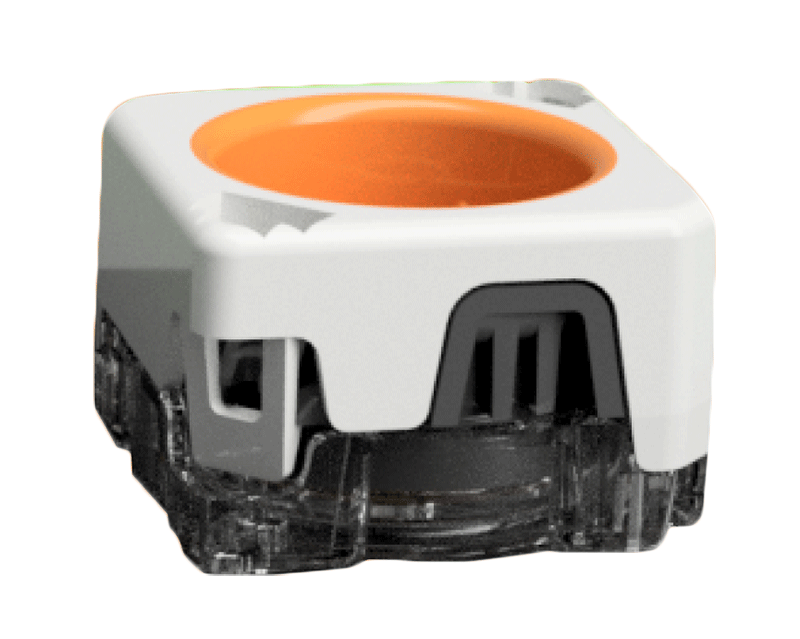
Description
The HIVE CLX™ scRNAseq Complete Bundle is the combined Sample Capture and Processing Bundles for the capture, transcriptome recovery, and library prep of single-cell samples.
The HIVE CLX™ scRNAseq Complete Bundle contains the parts and reagents to collect and process 8 samples. Indexing primers (HIVE™ UDI Plate) sold separately.
For research use only. Not for use in diagnostic procedures.
HIVE CLX single-cell RNAseq solution
Access new frontiers in single-cell biology
Developed by Honeycomb Biotechnologies, the HIVE CLX™ Single-Cell RNAseq Solution integrates sample storage and single cell profiling into a complete workflow, solving the issues that limit single cell RNA biology with the combination of unique benefits:
- Rare & fragile cell recovery
- Stable sample storage & shipping
- Instrument-free workflow
Making the HIVE CLX single-cell RNA-seq solution ideal for previously challenging applications:
- Innate immunology
- High quality granulocyte data (neutrophils, eosinophils, basophils)
- Multiple disease research areas: Oncology, neurology, developmental biology, respiratory & cardiac disease, transplantation
- Infectious disease research
- Collect samples in low resource setting, ship to high resource setting
- Diseases: HBV/HCV (hepatitis), HIV, malaria, tuberculosis, SARS-CoV-2
- Clinical research
- Overcome sample collection logistics for minimally invasive human biopsies
- Including: blood, bone marrow, cancer biopsies, nasal & dental swabs, BALs, FNAs, urine, CSF, and breast milk

The HIVE CLX single-cell RNAseq solution
 Enabling multi-site & multi-timepoint sample collection
Enabling multi-site & multi-timepoint sample collectionThe HIVE CLX single-cell RNAseq solution is a combined sample storage and single-cell profiling system. The HIVE CLX collector delivers versatility by enabling sample collection at different sites or at different timepoints and sample processing at the same location where they are collected or at a centralized processing laboratory.
Easy to use
The HIVE CLX single-cell RNAseq solution incorporates reagents and a single-use, handheld, shippable HIVE CLX collector that can be used in almost any lab environment. No specialized equipment is required to process the samples from single cells through library preparation and the workflow can be run in most labs.
The HIVE CLX single-cell RNAseq solution is compatible with both the Element biosciences and Illumina sequencing platforms.
Maintaining sample integrity
Cell quality is not compromised when using the HIVE collector during storage, shipping or processing. As can be seen in figure 1, single cell libraries prepared from fresh cells and cells stored at -20°C for 14 days prior to processing have similar profiles, showing no loss of cell population diversity, number of transcripts or genes detected.
Figure 1. Comparison between samples processed while fresh or stored at -20°C for 14 days prior to processing.
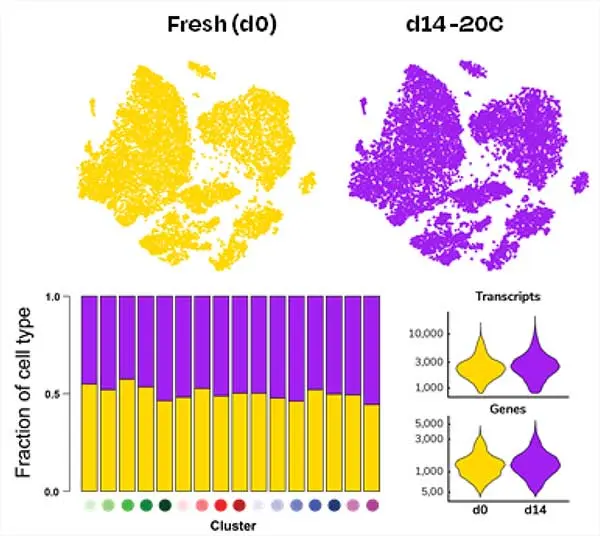
Increasing the recovery rates of fragile cells
Cells isolated using the HIVE collector settle gently into microwells within a matter of minutes. This change enables the analysis of cells that are typically difficult to analyze either because of their fragile membrane structures or because they have been stimulated or transfected which can induce fragility. Figure 2 shows the HIVE scRNAseq workflow is able to recover granulocytes which are difficult to detect with other platforms because of their fragility.
Figure 2. Illustrates 24,720 cells were captured in six HIVE collectors. The cell types processed include granulocytes such as neutrophils, eosinophils, and basophils.

Facilitating loading of larger sample volumes
Other systems for single cell analysis only allow small sample loading volumes, typically around 50 μL. To ensure you are not missing critical information available in the primary sample, the HIVE CLX single-cell RNAseq solution allows you to load much larger volumes of up to 4 mL.
Delivering flexible & scalable workflows
The HIVE CLX single-cell RNAseq workflow reduces experimental and inter-site variability seen in other single cell RNA-seq analysis platforms. The workflow also delivers flexibility of processing location and throughput. The samples can be easily processed where they are collected or stored and shipped to a central facility for processing. By allowing safe sample storage, samples can be batched to improve lab efficiency.
FAQ:
Sample preparation
Q. Are there HIVE-specific requirements for my sample prep?
A. We recommend whatever sample prep conditions are best suited for your sample type of interest. For the HIVE CLX Single cell RNAseq solution, final cell suspensions must be in media containing at least 1% FBS or 0.1% BSA.
Q. What do I do if there are clumps in my single-cell suspension?
A. If you are concerned about clumps, you can filter your sample through a 70 µm cell strainer before loading into the HIVE. Additionally, the wash step after cell-loading will help to remove large clumps and debris that do not fit into the 60 µm wells of the HIVE.
Q. How low can my cell viability be?
A. We recommend aiming for a cell viability >90%. The better the sample quality, the better the data. Samples of 70% viability still generate metrics within a 15% variation of the product specifications.
Q. Do you have a recommended protocol for removing red blood cells?
A. For red blood cell depletion from blood, we recommend using the EasySep RBC Depletion Reagent with the EasySep Magnet. We recommend processing 0.5 mL of blood at a time and using the magnet 2-3 times to get the best results. After using the EasySep system, we recommend washing the cells twice with cell media + protein to remove platelets and serum protein.
Sample Capture:
Q. What is the shelf-life of my HIVE Collectors?
A. The HIVE is currently verified for a shelf-life of up to 12-months after receipt when stored at -20°C.
Q. Are there alternative methods for thawing the HIVE Collectors?
A. Yes, thawing at 4C overnight is similar to thawing at room temperature for 30 minutes.
Q. How long can my HIVE Collector be at room temperature prior to cell-loading?
A. 1 hour, move to 4ºC if longer than 1 hour.
Q. How many cells can be loaded per HIVE collector?
A. For HIVE CLX scRNAseq processing we recommend loading 30,000 cells per HIVE collector. The loading range is 500-60,000 cells per HIVE collector. When counting, please load based on the number of live cells in the sample.
HIVE CLXscRNAseq loading
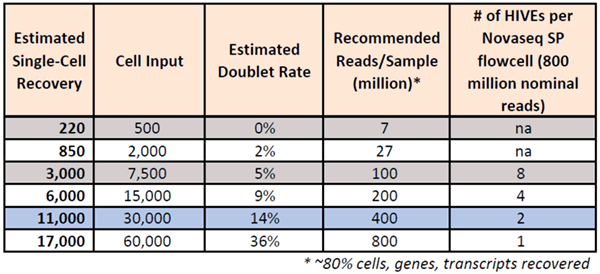
Q. What is the sample loading volume?
A. The standard loading method is 1 mL of sample (make up the rest of the volume with loading buffer if 1 mL of sample is unavailable). The capacity of the HIVE Collector is 4 mL. If volume is over the 4 mL capacity, load sequentially using the spin protocol by removing the supernatant after each spin.
Q. What sample types can I use?
A. HIVE CLX scRNAseq solution can be used with eukaryotic cells containing mRNA transcripts with 3’ poly-A tails. Cells should be smaller than 55 µm to fit into the wells. We have tested a variety of mammalian cell types, including human filtered blood, PBMCs, mouse splenocytes, and more
Q. Can I use an automated cell counter instead of the disposable hemocytometer?
A. Yes, but we recommend first doing a comparison with the hemocytometer to ensure that your cell counter is accurate. We recommend the Nexcelom K2 Cellometer.
Q. What type of media should I suspend my cells in before loading?
A. The HIVE CLX scRNAseq solution is compatible with a broad range of sample buffers. We recommend ~0.1% protein, but up to 10% FBS is okay. We recommend using PBS + 0.1% BSA for cell loading for optimal cell recovery. For the HIVE CLX scRNAseq solution, final cell suspensions must be in media containing at least 1% FBS or 0.1% BSA. An extra wash is recommended for >1% protein.
Q. How do you ensure that only one cell is entering each well?
A. The array is made of picowells that capture cells. Cell capture follows a Poisson distribution. While loading more cells increases single cell recovery, it also increases the rate of doublet formation.
Q. What is the doublet rate?
A. The following table gives the theoretical multiplate rate (%) for poisson loading based on the number of cells that were loaded
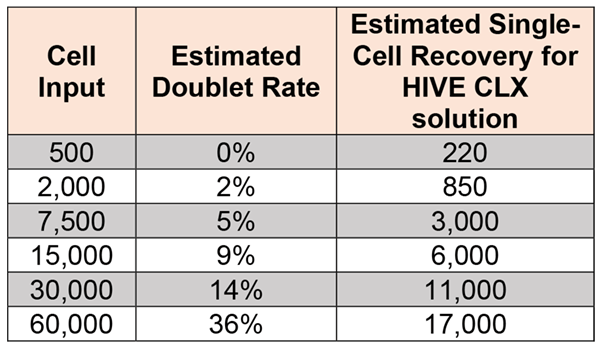
Storage and Shipping:
Q. How should I store my cell-loaded HIVE collector?
A. Cell-loaded HIVEs should be frozen. Storing your cell-loaded HIVE collector at -80°C is similar to storage at -20C.
Q. How long can I store a cell-loaded HIVE collector at -20°C?
A. HIVE CLX solution is currently verified for up to 3 months of storage at -20°C. Testing of longer storage periods is ongoing.
Q. Can I go directly from Sample Capture to Processing without storing cell-loaded HIVE collectors?
A. Yes, if you are not stopping after sample capture, let the cell-loaded HIVE collectors incubate with the cell preservation solution for 30 minutes before starting the processing protocol.
Q. Why do I have to ship cell-loaded HIVE collectors with dry-ice?
A. The Cell Preservation Solution does not fully freeze at -20°C. Cell-loaded HIVE collectors need to be fully frozen (while flat) for shipment.
Q. How should I store cell-loaded HIVE collectors that were shipped to me?
A. After receiving cell-loaded HIVE collectors that were shipped on dry ice, we recommend storing them at -80°C until processing. For more information, see the receiving instructions in the Sample Loading Protocol.
Processing and library prep:
Q. How many samples can I process at once and how long does it take?
A. Our workflow offers a high degree of flexibility, as each sample is independent. Under normal circumstances, 1 to 24 samples can be worked with in parallel and can be processed and ready for sequencing in 1.5 days.
Q. How do I know I have successfully recovered the beads from the HIVE collector?
A. After centrifugation, a compact white pellet will be visible at the bottom of the bead collector (more easily seen when holding the spin plate overhead). While removing 300 µl, beads will be present in the pipette tip, and the solution will appear cloudy. Afterwards, no pellet will be visible.
Q. Can I use a circular 96-well plate magnet instead of a bar magnet?
A. We recommend a bar magnet for ease of use, but other magnets are acceptable if you’ve successfully used them previously for SPRI clean-up.
Q. How do I dispose of my used HIVE parts?
A. Used HIVE parts can be disposed as non-sharps in standard bio-safety waste.
Q. Can the HIVE lysis solution inactivate infectious disease samples?
A. The lysis solution has been shown to inactivate SARS-CoV-2-infected human whole blood, but we recommend testing your specific samples.
QC, pooling and sequencing:
Q. What sequencing platform do you recommend?
A. HIVE CLX scRNAseq libraries are currently compatible with Illumina and Element Biosciences sequencing platforms capable of custom dual index paired-end sequencing. We recommend the Illumina NovaSeq, NextSeq 2000, or NextSeq 500/550 platforms and the Element AVITI System. Custom sequencing and index primers are provided with the Library Preparation Reagents
Q. How many reads are required for each HIVE sample?
A. Required reads can vary depending on number of cells, application, data quality, and sample types.
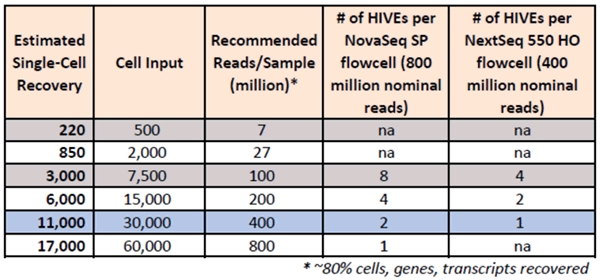
Q. Which sequencing kits do you recommend?
A. For Illumina sequencing platforms we recommend the Illumina NextSeq 500/550 – 75 High Output cycle kit, Illumina NextSeq 2000- 100 cycle kit, and the Illumina NovaSeq 6000 – 100 cycle kit
Q. What is the recommended sequencing configuration?
A. Dual indexed paired-end sequencing with custom sequencing primers R1: 25 R2: 50 I1: 8 I2: 8 The appendix in the Processing User Protocol goes into detail about setting up for sequencing.
Q. How can I check my sequencing quality?
A. Base quality metrics are used to assess the accuracy of sequencing technology. Illumina provides 2 metrics for assessing base quality: %PF (The percentage of clusters that pass Illumina’s preset filter) and %QC30 (The percentage of bases with a quality score of 30 or higher)
FastQC can be used to evaluate your sequencing data. FastQC is an open-source quality control tool for high throughput sequence data developed at Babraham Institute. More information and the download can be found at: https://www.bioinformatics.babraham.ac.uk/projects/fastqc/
Q. How should I demultiplex my samples?
A. Demultiplex based on the index 1 and index 2 read.
Q. When setting up for sequencing, what fragment size should I use?
A. We recommend using the nominal fragment size of 750 bp for calculating the molar concentration of HIVE libraries when loading Illumina sequencers, even if your fragment analyzer shows a different peak size. Please provide this information to your sequencing facility.
Software and analysis:
Q. What analysis software is provided?
A. The BeeNet software is specifically designed for the HIVE CLX scRNAseq solution. We also offer Terra users the BeeNetPLUS workflow for end-to-end analysis.
Q. What is the difference between BeeNet and BeeNetPLUS software?
A. BeeNet software can be downloaded and used on clusters or cloud via Linux command line. The input file is demultiplexed fastq files and output is a count matrix that can be used for secondary analysis as well as additional QC files. BeeNetPLUS software has a GUI interface and is hosted on Terra. The input is demultiplexed fastq files and output is an html file that goes through a brief analysis of your data, as well as the standard BeeNet output files.
Q. How can I access and use the software?
A. Please visit our Support page at honeycomb.bio for instructions on installation and analysis.
Q. Can I download example data?
A. Yes, data is available for download here
Q. What is the input file for the BeeNet analysis software?
A. Demultiplexed Read 1 and Read 2 FASTQ files from Illumina paired-end sequencing.
Q. Which reference genome for human do you use?
A. We have both hg19 and GRhC38 available for use.
Q. Can we use our own references?
A. If there is a reference you are interested in using and it is not available on BeeNet, submit a support request at honeycomb.bio and we can work with you to build a new reference file.
Q. Do I need to download references every time?
A. If you have already downloaded the references and they are still available in the same system, you do not need to download them again.
Q. Does the BAM file contain mapping quality information?
A. Yes it does, however, our BAM files do not contain molecule count information.
Q. Do you annotate intronic regions?
A. Intronic regions are annotated in the BAM file, but they are not included in molecule counts.
Q. What types of files does BeeNet generate?
A. BeeNet produces three types of files: BAM, count matrices, and quality metrics.


